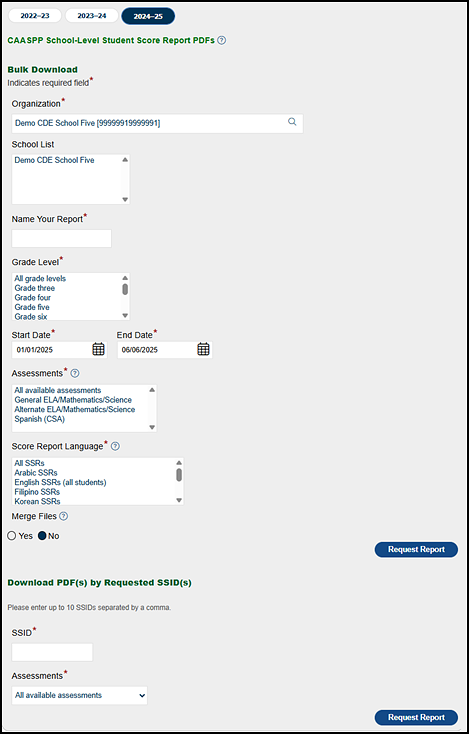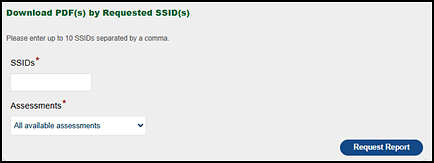Site CAASPP Reports
Site reports can be accessed by either LEA coordinators or site coordinators. Site reports contain data associated with the user’s role and school site.
To access a site report, select the [Reports] navigation tab from the top navigation bar, and then select the [Site Reports] action tab (figure 1).

Figure 1. Navigation for CAASPP site reports
The following site reports are available for CAASPP LEA coordinators or site coordinators. Select a link for details on a specific report.
- CAA for ELA School-Level Second Scoring Report
- CAASPP CARS School-Level Status Report
- CAASPP School-Level SSR Availability Report
- CAASPP School-Level SSR Distribution Report
- CAASPP School-Level STAIRS and Appeals Report
- CAASPP School-Level Student Completion Status Report
- CAASPP School-Level Student Score Report PDFs
- CAASPP School-Level Student Test Assignment Report
- CAASPP School-Level Student Test Settings Report
- CAASPP School-Level High School CAST and CAA for Science Eligibility Report
- CAASPP School-Level Student Demographic Snapshot Report
- School-Level Student Demographics Report
- Security Forms and Remote Administration Status Report
- Signed Security Forms Report
CAA for ELA School-Level Second Scoring Report
The CAA for ELA Second Scoring Report should only be used by LEAs and schools that have been assigned second scoring for the Summative Alternate ELPAC per the Summative Alternate ELPAC Second Scoring web page. The report displays students assigned second scoring for the CAA for ELA as well as the status of second-scoring entries in the DEI for either the LEA or school.
CAASPP CARS School-Level Status Report
The CAASPP CARS School-Level Status Report allows the user to download a list of CARS incidents for the selected administration. The user has the ability to filter the list based on current status of the incidents or to download all CARS incidents for the selected administration.
CAASPP School-Level SSR Availability Report
The CAASPP School-Level SSR Availability Report lists students who tested at the user’s school and have CAASPP SSRs that are available for download. After requesting this report, the user will receive a notification email when it is ready for download.
CAASPP School-Level SSR Distribution Report
This report lists all students who are registered for CAASPP at the user’s school. It includes each student’s SSR language preference as well as whether video SSRs were ordered for the student. Refer to Reporting in the Organizations chapter for details about how reporting options are set for an LEA or a school. Refer to Reporting in the Student Profile section for details on how to configure an individual student’s reporting options in TOMS. After requesting this report, the user will receive a notification email when it is ready for download.
CAASPP School-Level STAIRS and Appeals Report
The CAASPP School-Level STAIRS and Appeals Report provides details of CAASPP STAIRS and Appeals cases and their status at the school level. This report contains information about STAIRS cases, such as the school name and CDS code, the details of the assessment associated with the incident, the STAIRS case number, the STAIRS status, the date of the incident, the date the incident was submitted, and the Appeal number, type, and status.
CAASPP School-Level Student Completion Status Report
The CAASPP School-Level Student Completion Status Report contains the testing status of all students in the school for CAASPP. It provides student data, such as name, SSID, and grade level. This report also provides the status of test administrations (ELA, mathematics, science, and CSA) for each student and indicates whether the student is registered for the assessment, whether the student has started or completed the assessment, and whether a condition code (either PGE or NTE) has been assigned to the student for a given assessment.
CAASPP School-Level Student Score Report PDFs
The CAASPP School-Level Student Score Report (figure 2) allows the user to download a .zip file that contains CAASPP SSRs. The user can generate SSRs based on school(s), grade level(s), assessment(s), reporting language(s), and SSR availability date.

Figure 2. CAASPP School-Level Student Score Report PDFs options
Take these steps to access the bulk download report:
- From the Available Reports list, select CAASPP School-Level Student Score Report PDFs.
- The Organization field is prepopulated on the basis of the user’s logon credentials.
- From the School List, select the school associated with the SSRs. To select more than one school, hold the [Ctrl] key while selecting individual schools. To select all schools, select All Schools. This is a required field.
- In the Name Your Report field, enter a name for this report up to 25 characters. Note that spaces are not allowed. Allowable characters include uppercase and lowercase letters, hyphens, underscores, and the numbers 0 through 9.
- Select the grade level associated with the SSRs. To select more than one grade level, hold the [Ctrl] key while selecting multiple grade levels. To select all grade levels, select All from the Grade Level list. The grade level field is a required field.
- From the [Start Date] and [End Date] calendar [
 ] icons, select a start date and an end date so that only SSRs for students who are in the selected school(s) and grade level(s) during the specified date range are downloaded. These are required fields.
] icons, select a start date and an end date so that only SSRs for students who are in the selected school(s) and grade level(s) during the specified date range are downloaded. These are required fields. - Select the assessment associated with the SSRs. To select more than one assessment, hold the [Ctrl] key while selecting individual grade levels. To select all assessments, select All from the Assessments list. This is a required field.
- Select the score reporting language associated with the SSRs. To select more than one score reporting language, hold the [Ctrl] key while selecting individual score reporting languages. To select all score reporting languages, select All SSRs from the Score Report Language list. This is a required field. The options are as follows:
- All SSRs—Two sets of SSRs are generated for each student, one in English and one in the student’s primary language. Both sets of SSRs are downloaded for each student, per the student’s language settings.
- English SSRs (All Students)—Only English SSRs are generated for all students.
- English SSRs (English Only & Unsupported Languages)—English SSRs are generated for students whose primary language is English or any language other than Spanish, Filipino, Korean, Vietnamese, Mandarin, Cantonese, or Arabic.
- Spanish SSRs—Spanish SSRs are generated for students whose primary language is Spanish.
- Filipino SSRs—Filipino SSRs are generated for students whose primary language is Filipino.
- Korean SSRs—Korean SSRs are generated for students whose primary language is Korean.
- Vietnamese SSRs—Vietnamese SSRs are generated for students whose primary language is Vietnamese.
- Traditional Chinese SSRs—Traditional Chinese SSRs are generated for students whose primary language is either Cantonese or Mandarin.
- Arabic SSRs—Modern Standard Arabic SSRs are generated for students whose primary language is Arabic.
- Select the Yes radio button to merge the SSR PDF files into one or more files. The limit for the number of SSR PDFs per merged file is 10,000.
- Select the [Request Report] button to generate a new report.
- When a confirmation message appears, select the [Close] button to close the message.
- When the report is ready for download, the user will receive an email from ca-assessments@ets.org. The email directs the user to select the [Reports] navigation tab and then the [Requested Reports] action tab to get to the Requested Reports screen to download the report.
- Save the downloaded .zip file locally, and then open it to access all the SSRs.
Use the “Download PDF(S) by Requested SSIDs” section to download the SSR for an individual student who tested elsewhere and has since enrolled in the school. To obtain the SSRs of up to 10 individual students:
Enter the students’ SSID(s) in the SSIDs field (figure 3), and then select the [Download Report] button, located to the right of this field.

Figure 3. Download PDFs by Requested SSIDs options
CAASPP School-Level Student Test Assignment Report
The CAASPP School-Level Student Test Assignment Report allows CAASPP coordinators to verify student test assignments for CAASPP. This report generates a list of test assignments made in TOMS for students at a selected school in the LEA. CAASPP coordinators can use this report to verify student test assignments for CAASPP.
CAASPP School-Level Student Test Settings Report
The CAASPP School-Level Student Test Settings Report assists CAASPP coordinators in ensuring that appropriate embedded and non-embedded resources are assigned to students who need them. CAASPP coordinators can use this report to ensure that appropriate accessibility resources are assigned to students who need them. After requesting this report, the user will receive an email when it is ready for download.
CAASPP School-Level High School CAST and CAA for Science Eligibility Report
The CAASPP School-Level High School Eligibility Report for the CAST and CAA for Science allows coordinators to monitor the eligibility of high school students to register for the CAST and the CAA for Science. This report lists all high school students in grades ten, eleven, and twelve who are currently enrolled in the selected school regardless of their status (active or inactive). If a student has already taken a science assessment in high school, the report will indicate which science assessment the student took, when and where, and in which grade level. The report also will indicate which students are registered to take a science assessment in the current administration year.
CAASPP School-Level Student Demographic Snapshot Report
The CAASPP School-Level Student Demographic Snapshot Report includes a demographic record for each student enrolled in the selected school regardless of where the student tested. This snapshot is captured and available at the close of the LEA’s Smarter Balanced, CAAs for ELA and mathematics, and CAST LEA test administration window.
School-Level Student Demographics Report
The School-Level Student Demographics Report provides the current demographic information listed in TOMS. Coordinators can use this report to verify that correct information is being sent from CALPADS to TOMS.
Take the following steps to request this report:
- From the Available Reports list, select School-Level Student Demographics Report.
- Once the report is selected, the Organization field will be prepopulated on the basis of the user’s role.
- Select the school(s) for which this report is being generated. This is a required field.
- Select the [Download Report] button.
- Open the Excel file to access the school-level student demographic information.
Security Forms and Remote Administration Status Report
The Security Forms and Remote Administration Status Report generates a list of the Test Security Agreements and Test Security Affidavits that have been signed by users at the school and the date that they were signed. This list allows LEA coordinators and site coordinators to ensure that all appropriate staff have completed security information prior to testing. The User Remote Administration Enabled? field indicates "Yes" when the remote test administration is enabled for a user.
Signed Security Forms Report
The Signed Security Forms Report provides a copy of every user-signed Test Security Agreement and Test Security Affidavit for those at the school who have access to TOMS.
Take the following steps to access this report:
- From the Available Reports list, select Signed Security Forms.
- Once the report is selected, the Organization field will be prepopulated on the basis of the user’s logon credentials (figure 4).
- Select the [Request New Report] button to generate a new report. When the report is ready for download, the user will receive an email from ca-assessments@ets.org. The email directs the user to select the [Reports] navigation tab and then the [Requested Reports] action tab to get to the Requested Reports screen to download the report.
-
Open the Excel file to access a list of users and the status of all security forms.

Figure 4. Signed Security Forms options

